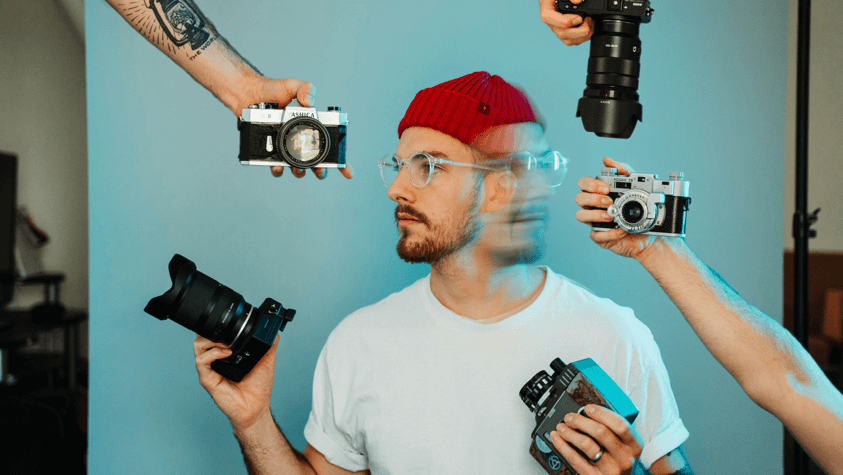By TACP Staff on July 19, 2019

Professional photographers earn a living by taking pictures of the world around them. As simple as this makes the profession sound, it misrepresents the significant difference in expertise between an amateur or hobbyist and a professional who has spent years honing their craft through training, study and practice. Professional photographers are masters of advanced concepts and techniques, such as focus, color, composition, lighting, exposure, and depth-of-field, as well as the technical mechanics of operating a camera and photo production.
Photographers use their technology (cameras), creativity, and technical expertise to preserve images in history, tell a story, or record an event. And, although many of the skills necessary to be a successful photographer are inherent, and postsecondary education is not always required to find a job, many professional photographers will attend a photography school, or a private art school to learn advanced techniques and hone their craft.
Classes in college typically cover processes, technique, equipment, and design and composition. A keen eye for detail, artistic and creative ability, good communication and people skills, and the ability to meet deadlines are all skills a photographer should have, no matter where they work. Even freelance photographers with no or little formal training must have skills and knowledge beyond the ability to take a great photo. Plus, they will need to sharpen their people skills in order to gain new clients, either by word of mouth or through showing their work online or in-person.
The field of professional photography is competitive, and clients dictate when and where you work; outdoors in all kinds of weather, indoors with poor lighting, or late at night at a New Year’s party. Many photographers travel to photo shoots, and are required to move and carry heavy equipment. Photographers are also often called on last minute when clients’ plans change or news develops. For example, news or aerial photographers may work weekends or overtime to capture the news or an event as it happens.
Some people think that it requires very little skill to take a good photograph, especially since more and more smartphones and tablets have options like a 2x optical zoom, or a 12-megapixel dual-pixel sensor, or a wide f/1.7 aperture for bright and vivid photos, especially in low-light conditions. But when a bride wants her wedding immortalized for all time, or a news station demands detailed photos of a crime scene, or a college needs a new brochure featuring photos of the campus, they don’t often reach for their smartphones. They call a trained photographer.
That’s why a career as a professional photographer is so much more than just a hobby. And, why career-minded photographers must have a firm grasp of the concept(s) behind each photo, the methodology that goes into framing a good photo, the right equipment to use, and the techniques needed to pull it all together. Trained photographers know their cameras and their craft inside out. Can you imagine being at a wedding and the bride is walking down the aisle, but the “person taking the photos” is fumbling through a manual because he or she isn’t sure which f-stop to use? Sometimes a professional photographer will only have a couple of seconds to adjust the setting on the camera so that a once-in-a-lifetime shot isn’t missed.
Although quite obvious, professionals must know the basic parts of a camera; zoom and wide-angle camera lens, memory cards, shutter speeds, f-stops, focal planes, depth of field settings, etc., which all may seem a bit dull, but are very necessary to create great photos. Setting a camera on “automatic” will never give the same professional results. Photographers must have extensive knowledge of lighting techniques, and how ever-changing lighting conditions play a part in framing a good photo. They must understand color and have a thorough knowledge of color theory, along with an understanding of over and underexposure techniques. A photographer will understand the various software needed to alter, enhance or edit a photo, such as Adobe Photoshop CC, Affinity Photo, Pixlr, Lightroom, Photo Plus, and Acorn, just to name a few.
A portfolio is a photographer’s best friend, and often the most important component in a photographer’s career. It is the first impression most employers see, and is usually how a photographer’s work is judged and evaluated. Creating a top-notch portfolio can make all the difference in getting an internship, landing a job, selling your work, building your reputation, or being shown the door. Your portfolio should contain only your very best work, preferably work you’ve completed recently. It should also contain a wide range of photos; landscapes, portraits, black and white and color photos, and should also show a wide range of techniques.
A strong personal brand is also very important, as it identifies you as marketable to potential employers or as you pursue a freelance career. Your brand highlights your talent and accomplishments and sets your work apart from others in the field. Connections in the industry are also important to a photographer’s success, as word of mouth is second-to-none to landing a job. Networking can begin in school, through internships, clubs, or by joining associations and attending photography shows. Some photographers may find it difficult to network, and others may completely dismiss it as a waste of time. But, as time-consuming and uncomfortable as it can be networking is vitally important to a photographer’s career (second only to a professional portfolio).

The Art Career Project is a trusted resource for emerging and professional artists.